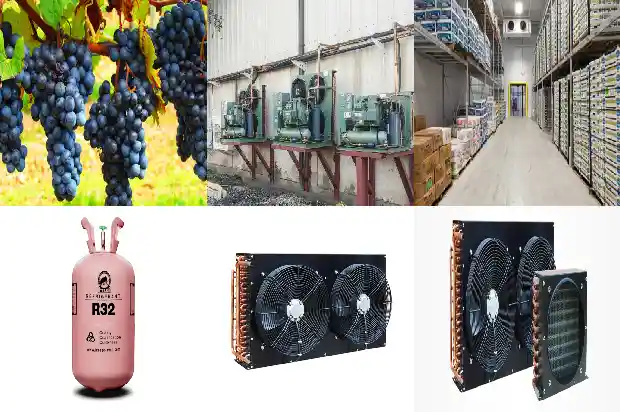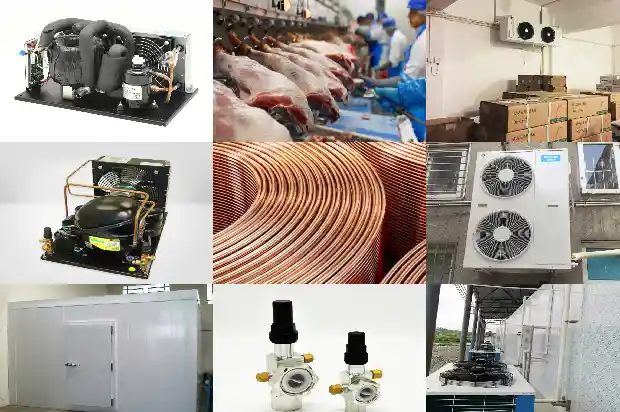What Knowledge Points Should Users Know about the Safety Valve in the Refrigeration System?
2025-04-12
On pressure vessels and pipelines, safety valves are usually used to control the pressure inside the vessel so that it does not exceed the specified value, thus protecting personal safety and the safe operation of equipment. A safety valve is an automatic valve that uses the pressure of the medium itself to automatically open the valve and discharge a certain amount of the medium, preventing the pressure borne by the vessel or pipeline from exceeding the rated safety value. When the pressure returns to normal, the safety valve closes by itself and prevents the medium from continuing to flow out. The types of safety valves include directly loaded safety valves, safety valves with power-assisted devices, safety valves with supplementary loads, and pilot-operated safety valves. Let's first understand several key terms related to safety valves:
- Set pressure: The predetermined pressure at which the safety valve starts to open under operating conditions, which is the gauge pressure measured at the valve inlet. At this pressure, the valve disc automatically opens, and the medium is quickly ejected. It is also called the opening pressure.
- Relief pressure: After the valve disc of the safety valve is fully opened, the pressure at the valve inlet. The relief pressure is equal to the set pressure plus the excess pressure.
- Re-seating pressure: After the safety valve discharges, when its valve disc comes into contact with the valve seat again, that is, the static pressure at the valve inlet when the opening height becomes zero. It is also called the closing pressure.
- Working pressure: The pressure of the medium when the equipment is operating normally, at this time, the safety valve is in a sealed state.
- Discharge capacity: When the valve disc of the safety valve is in the fully open state, the amount of medium discharged per unit time measured at the outlet.
In the design specifications of the refrigeration system, it is generally required that the pressure generated during the operation, storage, and transportation of the refrigeration system should not exceed 10% of the maximum working pressure of any component. Therefore, the pressure setting, release, and control need to be carried out through safety valves at the key parts of the system.
The safety valve in the refrigeration system is a pressure-driven valve that is kept closed by a spring or other means. Its design principle is that when the pressure exceeds the set value, it will automatically release the pressure, and when the pressure drops below the set value, it will close again and prevent the fluid from flowing further.
For some containers with a small capacity, a fusible plug is sometimes used instead of a safety valve. A fusible plug or fusible element is a safety device with a material inside that can melt at a predetermined temperature. The melting temperature of the fusible material should be marked on the non-melting part of the fusible plug. The fusible plug should be installed on or near the pressure vessel or the component it is intended to protect, and the fusible plug should not be thermally insulated.
According to the requirements of relevant national standards, before leaving the factory, the safety valve should be sealed with a lead seal after testing and setting. The identification mark of the valve manufacturer or other competent department or person in charge should be marked on the sealed part. The set pressure, rated discharge capacity, flow coefficient of the specified refrigerant, and flow area should all be marked on the sealed part or the valve body.
Therefore, when purchasing a safety valve, pay attention to checking these marks.
- Marks on the valve body of the safety valve: The marks on the valve body can be made together with the valve body or marked on a nameplate fixed to the valve body. At least the following contents should be marked on the valve body of the safety valve:
1.1 Inlet diameter DN;
1.2 Valve body material code;
1.3 Manufacturer's name or trademark;
1.4 An arrow indicating the flow direction of the medium. - Marks on the nameplate: At least the following contents should be marked on the nameplate fixed to the safety valve:
2.1 The limiting working temperature designed for the valve, in °C;
2.2 Set pressure, in MPa;
2.3 The product model of the manufacturer;
2.4 The rated discharge coefficient or rated discharge capacity (indicating the unit) marked with the reference fluid (G for air, S for steam, and L for water). The fluid code can be placed before or after the rated discharge coefficient or rated discharge capacity. For example, G - 0.815 or G - 100,000 kg/h;
2.5 Flow passage area, in mm², or flow passage diameter, in mm;
2.6 Minimum opening height, in mm, and the corresponding excess pressure (expressed as a percentage of the set pressure). - Lead seal of the safety valve: All safety valves should be sealed with a lead seal by the manufacturer, its representative, or the relevant responsible institution.
- Installation of the safety valve: When selecting a safety valve, appropriate consideration should be given to the climatic conditions, process conditions, or other environmental conditions that may have a negative impact on the performance of the safety valve. Oscillation or hammering phenomena can lead to a reduction in the discharge capacity of the safety valve or damage to the sealing surface and other parts. To minimize such risks, pay attention to the following matters when installing the safety valve:
4.1 The safety valve must be installed vertically upwards at the top of the container or the upper part of the pipeline. If it is intended to install the safety valve in a non-vertically upward position, the consent of the manufacturer should be obtained, and pay attention to making the arrow indicating the flow direction of the medium point in the correct direction.
4.2 When the safety valve is installed on an inlet branch pipe, the minimum cross-sectional area of the branch pipe should not be smaller than the inlet cross-sectional area of the safety valve.
4.3 The installation position of the safety valve should be as close as possible to the protected system, and its inlet branch pipe should be short and straight. For high-pressure and/or high-discharge capacity occasions, the inlet branch pipe should have a sufficiently large fillet radius at its inlet, or have a conical passage, and the cross-sectional area at the inlet of the conical passage is approximately twice that at the outlet.
4.4 The inlet branch pipe of the safety valve should not be set directly opposite to a certain branch pipe.
4.5 The pressure relief port of the safety valve or the fusible plug should be in a position where people will not be harmed by the escaping refrigerant. The discharged refrigerant can be discharged into the atmosphere by an appropriate method, but it should be far away from the ventilation intake of the building, or it can be discharged into an appropriate absorption solution. - Knowledge points of adjustment, maintenance, and repair of the safety valve:
5.
1 The adjustment and repair of the safety valve, including changing the set pressure, should be carried out by the manufacturer of the safety valve, or the representative authorized by the manufacturer, or the personnel who have obtained the corresponding qualifications through professional training. According to relevant national regulations, the safety valve must be verified once a year by the special inspection institution in the location. A newly manufactured safety valve should be verified before use. A safety valve that has been disassembled, repaired, or had its components replaced should be verified again.
5.2 The key spare parts used for repairing the safety valve should be provided by the original manufacturer; if they are manufactured by an authorized agency, they should meet the technical requirements of the original parts. The so-called "key parts" refer to the parts whose design conditions have a crucial impact on ensuring the performance of the safety valve, including at least the nozzle (valve seat), valve disc, valve disc seat, valve disc core, guide sleeve, valve stem or valve stem assembly, adjustment ring, and spring.
5.3 If the set pressure of the safety valve needs to be changed, inquire with the manufacturer about the suitability of the valve design for the changed working conditions. The manufacturer should decide whether it is necessary to replace the spring. Only springs that meet the manufacturer's standards can be used. The institution responsible for changing the set pressure should install a nameplate on the valve indicating the set pressure and the changes in other relevant parameters. The original marks that have been changed should be crossed out but remain identifiable.
5.4 The safety valve should be confirmed for its set pressure and tightness at least through tests.
5.5 A nameplate indicating the institution responsible for the repair should be permanently installed on the safety valve (if the institution responsible for the repair is not the valve manufacturer, it is recommended to install the nameplate close to the manufacturer's nameplate). After the valve passes the test, the institution responsible for the repair should seal all external adjustment mechanisms with a lead seal.
Related Articles
- Do You Know These Basic Refrigeration Knowledge?
- Basic Knowledge of Valve - type Components in Refrigeration Systems (Technical Sharing)
- Do You Know All These Knowledges about the Absorption Unit of the Lithium Bromide Refrigeration Machine?
- HVAC - Comprehensive Knowledge You Must Know about Cooling Towers
- The Most Comprehensive Popular Science of Refrigeration and HVAC Basic Knowledge Across the Network!
- Understand These Refrigeration Knowledge to Boost Your Style!
- Basic Knowledge of Cold Storage Maintenance
- The Most Comprehensive Knowledge of Refrigeration Oil, Definitely Useful in the Future!
- Popularize Refrigeration Knowledge You've Never Noticed, Which Is Actually Very Crucial
- Practical Knowledge on Freeze Protection of Air - conditioning Equipment
- Basic Knowledge of Valve - type Components in Refrigeration Systems (Technical Sharing)
- Basic Knowledge of Cooling Towers
- Knowledge, Installation and Maintenance of Cold Storage Systems
- Obscure Knowledge of Static Pressure, Dynamic Pressure, Latent Heat and Sensible Heat in the HVAC Industry
- Fin Spacing Design of Cooler and Several Knowledge Points of Defrosting in Cold Storage
- Precautions for Refrigerant Charging and Maintenance Key Points of R410A Refrigerant Air Conditioners
- Introduction: Ten Key Points Every Refrigeration Professional Should Know
- HVAC Construction Technology and Management: All Key Points to Note Are Here!
